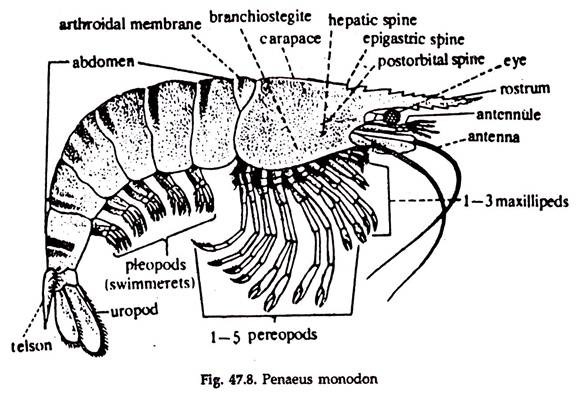In this article we will discuss about the prawn culture in India.
A. Important cultural prawns and their importance in fishery:
A good number of prawn species are of commercial value.
The following are important:
ADVERTISEMENTS:
a. Penaeus indicus (Fig. 47.8):
Maximum size 230 mm. One of the most important commercial species. Young ones are fished in estuary.
b. Penaeus monodon:
Maximum size 320 mm. An important commercial species. Good fishery in West Bengal and Orissa.
ADVERTISEMENTS:
c. Metapenaeus monoceros:
Maximum size 180 mm. Very important commercially.
d. Metapenaeus brevicornis:
Maximum size 125 mm. Good fishery in northern region of south and east coasts. Juveniles are also fished in estuary.
ADVERTISEMENTS:
e. Palaemon styliferus:
Maximum size 90 mm. One of the most important fishery in Gangetic delta.
f. Macro brachium rude:
Maximum size 130 mm. Good seasonal fishery in West Bengal and Orissa.
g. Macro brachium Rosenberger (Fig.25.1):
Maximum size 320 mm. Very good fishery in monsoon and post-monsoon months in Kerala.
h. Macro brachium malacolmsonii:
Maximum size 230 mm. Fairly good fishery in Northeast coast in monsoon months.
B. Prawn seed collection: sites and time:
ADVERTISEMENTS:
The creeks, canals and shallow waters, preferably with sloping sides, are suitable places for seed collection. The lunar phases are the best time period for collection.
Different types of gears are used for collection:
a. A battery of nets are operated in longitudinal rows in shallow water.
b. The shooting net is suitable for the pelagic forms.
c. Scoop nets and drag nets are used in intertidal pools and shallow inundations.
Different species of prawn do not breed in confined water. Induced breeding with hypophysation has been a success.
C. Prawn culture in brackish water:
Four types of prawn culture are prevalent in West Bengal:
a. Only stocking and harvesting without any care to prawn population and food supply.
b. Stocking of known quantity and cultured with natural food.
c. Stocking at higher concentration and extra nutrient added. In this method, production can be increased by 500 per cent.
d. Stocking selected prawns at higher concentration with fertilisation, supplemental feeding and stock manipulation.
1. Pond preparation:
a. Prior to stocking, the culture pond is dewatered and its bed is exposed to sun to dry. It helps in high soil fertility.
b. Mohua oil cake, an organic toxicant, is spread over the bed at a rate of 100 to 150 kg/ha and water is drawn to a depth of 4 to 5 cm.
c. The toxin dissolves in water and the unwanted organisms are killed.
d. The water is again drained out after 2-3 days and the pond is flushed with fresh tide water to wash away rest of the toxicants.
2. Fertilisation:
a. For a better growth of prawn food organisms, manuring of ponds is essential.
b. This is repeated monthly with oil cake @ 50 to 100 kg, urea and superphosphate each 50 kg/ha.
3. Water management:
a. Water is periodically drawn through inlets guarded with close mesh screen.
b. This prevents entry of undesirable organisms and also escape of prawn.
c. The optimum ranges are—temperature 25-30’C; dissolved oxygen 4-8 PPM; pH 8.0.
4. Stocking:
Fry and fingerlings are directly stocked in ponds:
a. Stocking density is high in brackish water than in fresh water as the growth rate is slow in the first.
b. Supplementary feeding is done depending on the stocking density and productivity of the pond.
c. Stocking density largely depends on the culture practiced:
i. Single stocking and single harvest.
ii. Single stocking and multiple harvest.
iii. Multiple stocking and multiple harvest.
5. Supplementary feeding:
Shortage of natural food needs supplementary feeding. It leads to a better growth in a pond where prawns are stocked at a high concentration.
6. Harvest:
a. Partial harvesting is done by setting bag nets at the outlet during low tide.
b. Total harvest is possible only with complete dewatering.
Prawn culture in Kerala:
Prawns are cultured in backwaters along with paddy crops. This is known as paddy cum prawn culture. Juveniles of all commercially important species are trapped in paddy field.
a. The variety of paddy ‘Pokali’ is harvested in September.
b. From now onwards the salinity of paddy fields gradually increases and prawn juveniles are allowed to enter with water through controlled sluice gates.
c. In and outflow of water are allowed daily during high and low tides but prawns are prevented to escape with bamboo mats placed inside the gates.
d. In April, the culture comes to an end. Prawns are completely harvested by repeated netting and dewatering of the field.
Problems of prawn culture:
The hazards of brackish water prawn culture are:
a. Mechanical:
i. Structural failure of water gates.
ii. Landslide from dykes.
iii. Erosion and silting up of farm ponds.
iv. Overflowing of ponds.
b. Physical:
i. Temperature
ii. Turbidity of water.
c. Chemical:
i. Salinity.
ii. Organic pollution of farm ponds.
iii. Oxygen deficiency.
d. Biological:
i. Parasites and diseases.
ii. Pests.
These, however, can be controlled with proper care.
